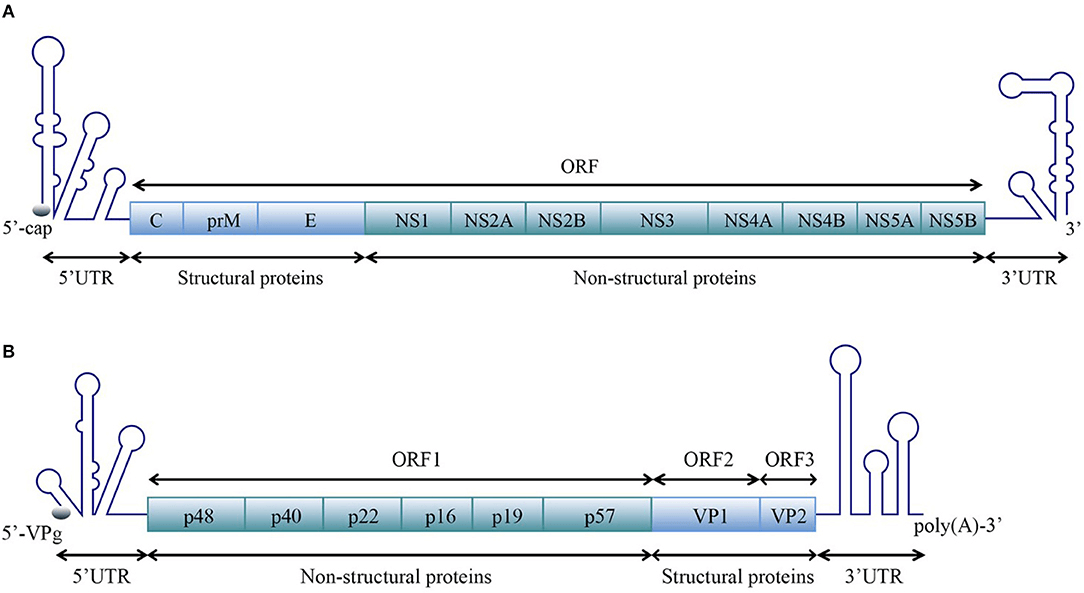Positive-sense Single-stranded RNA Virus
The 3' untranslated region (3' UTR) of positive-sense single-stranded RNA [ssRNA(+)] viruses is highly structured. Multiple elements in this region interact with other nucleotides and proteins of viral and cellular origin to regulate various aspects of the viral life cycle, such as replication, translation, and host cell responses. The genomic RNA of all ssRNA(+) viruses functions as mRNA and is directly translated to produce one or more polyproteins. After the ssRNA(+) virus invades the host cell, its RNA will be translated by the host ribosome to produce one or more polyproteins. These polyproteins will be rapidly cleaved by viral and/or cellular enzymes to generate several structural and non-structural proteins that are not involved in assembling the complete viral particle. Similar to the 3' UTR of mature eukaryotic mRNA, the 3' UTR of ssRNA(+) viral genomic RNAs has a variety of functional primary and higher-order structures. For the analysis of some ssRNA(+) viruses whose sequences are reported, localization analysis can be performed by fluorescently labeled molecular probes. Our platform provides customization of visual analysis solutions for this type of virus.
 Fig 1. Schematic representation of the organization of the ssRNA(+) virus genome. (Liu Y, et al. 2020)
Fig 1. Schematic representation of the organization of the ssRNA(+) virus genome. (Liu Y, et al. 2020)
Custom Solutions for ssRNA(+) Virus Visualization Analysis
Our experimental platform provides customized services for visual analysis solutions for this type of virus. This service enables probe design and customization (including positive and negative controls) to target specific gene regions of the region of interest or across the genome based on published sequence data or sequencing data. Customized probe customization solutions and analysis methods can better meet the needs of customers so that customers can obtain high-quality data results. We offer customization of visualization analysis solutions for several Flaviviridae genus RNA viruses, such as West Nile virus (WNV), Japanese encephalitis virus (JEV), dengue virus (DENV), Murray Valley encephalitis virus (MVE), tick-borne encephalitis virus (TBEV), Yellow Fever virus (YFV), and Zika virus (ZIKV).
Taking the ZIKA virus as an example, its major structural proteins (capsid (C), precursor membrane (prM), envelope (E)) and nonstructural protein (NS) are encoded by more than 10,000 bases. The proteins comprise smaller hydrophobins (NS2A, NS2B, NS4A, and NS4B proteins) and larger and highly conserved proteins (NS1, NS3, and NS5). Commercial probes for the published sequences of the ZIKA virus have been designed, and our analytical testing services can be carried out through these commercial probes, as well as personalized customization services. Other viruses you are interested in can be customized by consulting our experts.
 Fig 2. FISH detection service for positive-sense single-stranded RNA viruses.
Fig 2. FISH detection service for positive-sense single-stranded RNA viruses.
Our Features
Our analytical testing services provide ISH methods with short analytical cycle times based on visual probes.
Our ssRNA(+) viral probe design and customization service enable differential detection. Flexible probes for the sense or antisense strands can be designed to detect and distinguish different stages of the virus. For example, a probe targeting the sense strand can detect viral genomic RNA, and a probe targeting the antisense strand can detect complementary RNA.
Creative Bioarray provides a variety of technical service options from gene editing to stable cell line construction to help our customers save costs. You will benefit from our technical expertise and complete platform, and work with you to find the best solution to meet your needs.
If you are interested in our service, please contact us for cooperation. We look forward to cooperating with you in the near future.
Reference
- Liu Y, Zhang Y, Wang M, et al. Structures and functions of the 3'untranslated regions of positive-sense single-stranded RNA viruses infecting humans and animals[J]. Frontiers in Cellular and Infection Microbiology, 2020, 10: 453.


 Fig 1. Schematic representation of the organization of the ssRNA(+) virus genome. (Liu Y, et al. 2020)
Fig 1. Schematic representation of the organization of the ssRNA(+) virus genome. (Liu Y, et al. 2020) Fig 2. FISH detection service for positive-sense single-stranded RNA viruses.
Fig 2. FISH detection service for positive-sense single-stranded RNA viruses.


